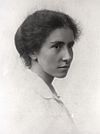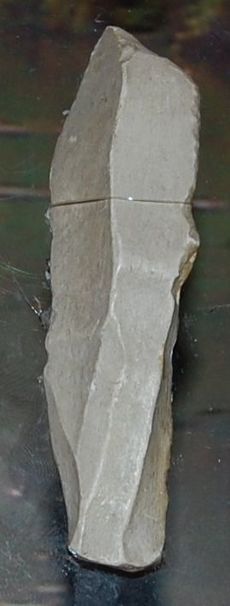Creswellian culture facts for kids
 |
|
| Geographical range | Great Britain |
|---|---|
| Period | Upper Paleolithic |
| Dates | between 13,000–11,800 BP |
| Type site | Creswell Crags |
| Major sites | Gough's Cave, Kents Cavern |
The Creswellian was an important ancient culture in Great Britain. It existed during the Upper Paleolithic period. This culture is named after a special place called Creswell Crags in Derbyshire. A famous archaeologist named Dorothy Garrod first used the name "Creswellian" in 1926.
Sometimes, the Creswellian culture is also called the British Late Magdalenian. Experts believe the Creswellian and another culture called Hamburgian were closely related. They both came from the Magdalenian culture. The Creswellian period lasted from about 13,000 to 11,800 years ago. After this time, a major ice age called the Younger Dryas began. During this ice age, people often left Britain because it became too cold.
Contents
History of the Creswellian Name

The name "Creswellian" first appeared in 1926. It was in a book by Dorothy Garrod called The Upper Palaeolithic Age in Britain. This book was very important. It was the first major academic work by Dorothy Garrod. Later, in 1939, she became the first woman professor at Cambridge University.
Her book was also the first detailed study of the Upper Paleolithic period in Britain. It remained the only one for 50 years! Over time, the meaning of "Creswellian" became clearer. Today, it specifically describes the Late Magdalenian-style tools found in Britain.
Tools and Life of the Creswellian People
Special Tools and How They Were Made
Creswellian people made unique tools. These included sharp, trapezoid-shaped blades called Cheddar points. There were also similar tools known as Creswell points. They also made smaller blades called bladelets. Another common tool was the end scraper. These were made from long, straight blades.
The Creswellian people had a special way to make their tools. They would strike a stone core in one direction. This created a distinct "spur" on the platform where they hit it. They used a soft hammerstone or an antler hammer to shape their tools.
Other Finds and Crafts
Archaeologists have found more than just stone tools. They have discovered items made from Baltic amber, mammoth ivory, and animal teeth and bone. These materials were used to create useful objects. Examples include harpoons for hunting, awls (for piercing), beads for decoration, and needles for sewing.
Unusual ivory rods with slanted ends, called sagaies, have also been found. These were discovered at Gough's Cave in Somerset and Kent's Cavern in Devon.
Where They Lived and Traveled
Archaeologists have found Cheddar points at 28 sites in England and Wales. So far, none have been found in Scotland or Ireland. This suggests that humans did not settle in those areas until later. Most Creswellian sites are caves. However, there is growing proof that they also lived and worked outdoors.
The Creswellian people often used specific sources of flint. They would travel long distances, sometimes up to 100 miles, to get the best materials for their tools. For example, some flint found at Gough's Cave came from the Vale of Pewsey in Wiltshire. They also used seashells and amber from the North Sea coast. This shows that these ancient people moved around a lot.
This movement is similar to what we see in other Magdalenian cultures in Europe. It might mean that they traded goods. They may have also sent out special groups to find raw materials. When they prepared flint, they would often reduce its size at the source. This made the lighter blades easier to carry as part of their "toolkits." Some archaeologists even believe that the same group of people made flint tools found at Kent's Cavern and Creswell Crags.
What They Ate
Creswellian hunters mainly ate wild horses (Equus ferus) or red deer (Cervus elaphus). What they ate likely depended on the season. They also hunted other animals. These included the Arctic hare, reindeer, mammoth, Saiga antelope, wild cow, brown bear, lynx, Arctic fox, and wolf.
At Gough's Cave in Cheddar, scientists found very broken human bones. These bones had marks on them. These marks suggested actions like skinning, taking apart, removing flesh, and getting marrow. Human and animal remains were mixed together. The human bones showed the same marks as the animal bones. Scientists believe this means the Creswellian people processed human remains in a similar way to animals. This could have been for survival or for ritual reasons.
See also
- Hamburg culture


